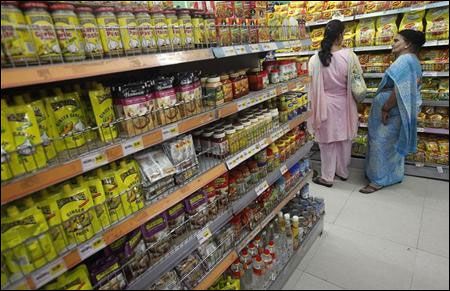
With more people now willing to buy goods online, the value of India’s online sales in 2015 is expected to be thrice as much as last year.
While marketplaces like Amazon, eBay, Flipkart and Snapdeal have increased choices by adding sellers on their platforms and improving delivery efficiency, it is estimated that Indian e-commerce companies’ combined gross merchandise value this year will be over $12 billion (Rs 78,000 crore) by December, compared with $4.5 billion (Rs 29,000 crore) last year.
Amazon has seen its India sales growing four times this year, with the American e-commerce giant tripling the number of sellers on its platform.
Snapdeal’s business has soared to a new level, with the Kunal Bahl-led company cutting its product delivery time to as low as four hours in many cities.
Its consumer base has grown three times over last year. During its Diwali sale, the company sold over five million products in three days.
Similarly, Flipkart’s sales grew significantly during its Big Billion Day sale to an estimated $300 million during the five-day event.
Among them, Amazon, Flipkart and Snapdeal control nearly 80 per cent of the country’s e-commerce market, even as competition is set to get more intense with Reliance Industries betting on offering goods online by March.
It is not just the big players that are gaining market share with people increasingly moving to shopping through their smartphones; even smaller e-commerce players are benefiting from the changing trend.
“The overall ecosystem is growing.
"The good part is that many small guys are also growing rapidly with an increase in their shopper base and GMV.
"Even a niche e-commerce firm in furniture or baby goods is growing three to four times a year,” said Nitin Bawankule, head of e-commerce at Google India.
Rural-focused online commerce firm StoreKing says it has grown 10 times this year while focusing on selling goods to the un-served rural markets in India.
The firm, which has an average order value of Rs 1,200, has crossed Rs 400 crore (Rs 4 billion) in GMV this year.
It expects its business to remain high, as its rural customer base has limited access to traditional shops.
“We are close to breaking even this year,” says Sridhar Gundaiah, founder of StoreKing.
“We offer convenience, not discounts. We have depth in our inventory and catalogue, and we do not ship any consignment with value less than Rs 500.”
Yepme, an independent online fashion brand, expects its sales to grow between 150 per cent and 200 per cent in the current calendar year. It is aiming at increasing its revenue to $80-100 million over the next 12 months.
“Our user base is close to 5 million, which is quite large for an independent online fashion brand. We expect growth to double this year,” says Sandeep Sharma, co-founder and chief technical officer of Yepme.
Indian e-commerce companies are expected to see their combined GMV nearly tripling over last year to over $12 billion by the end of this calendar year, according to Google.
In 2016, the e-commerce market is projected to be worth around $18-20 billion.
The Indian shopper base, largely on smartphones, would increase to 60 million in 2015, up from around 40 million last year.
Likewise, over half a million small firms are registered with e-commerce marketplaces selling goods from smaller towns to consumers across the country.
“We are encouraged with what we are seeing, both in terms of customers and sellers.
On the customer side, active customer accounts have risen 230 per cent over a year ago. We are in the middle of the Diwali season, which is going well.
Sales this season have been four times as much as the year-ago period,” Brian T Olsavsky, chief financial officer of Amazon, had said in a conference call last week.
Growth is also coming on the back of increased investment by firms like Amazon, Flipkart and Snapdeal, to expand the market.
EBay, another global e-commerce marketplace that has lost its share to Amazon in several geographies, says it could emerge as a serious contender in the Indian market.
“There is a plenty of hype, but there is also a good deal of reality in India.
It is a growing market, it is exciting, and there will be multiple winners.
"We will be one of them,” Scott Schenkel, chief financial officer & senior vice-president, eBbay had said in an investors’ call last week.
Snapdeal, an early entrant in India with a marketplace model, has a significant consumer and seller base in the country today.
The home-grown e-commerce firm, which declined to reveal its yearly sales growth, is aiming to hit $10 billion in GMV by March 2016.
The company’s GMV target for the same month a year earlier was $3 billion.
Flipkart has also estimated similar growth numbers.
During the Diwali sale, Snapdeal said it registered a 10-fold growth in electronics sales and a four-fold increase across other categories.
“Every year, Diwali traffic goes up by a few hundred thousands.
"What is surprising is that the traffic does not go back to the previous rate in the week after Diwali. And, the new figure becomes the base for the next year,” Snapdeal’s chief product officer, Anand Chandrasekaran, had said on October 14.
Nearly 40 per cent of India’s retail consumption takes place during the holiday season from September to December. Flipkart, which shifted its focus on the mobile app to get more consumers to buy within its walled environment, says this year the business will surpass that in 2014 in terms of both value of transactions and growth in volume.
“Compared to last year, we have seen much better numbers for growth and transactions this year,” Saurabh Chandra, head off apps at Flipkart, had said over the weekend without giving details.
THE BIG E-DADDIES
- Amazon has seen its India sales growing four times this year, with the US e-tail giant tripling the number of sellers on its platform
- Snapdeal’s business has soared to a new level, with the company cutting its product delivery time to as low as 4 hours in many cities
- During its Diwali sale, the company sold over 5 million products in three days
- Flipkart’s sales grew significantly during its Big Billion Day to an estimated $300 million during the five-day event
Amazon, Flipkart & Snapdeal control nearly 80% of the e-commerce market even as competition is set to increase with Reliance Industries entering the segment by March 2016









